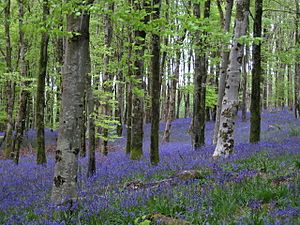Hooke Park facts for kids
Hooke Park is a special forest in Dorset, England. It's a big woodland, about 142 hectares, which is like 350 football fields! This forest is very old, known as an ancient woodland. Long ago, it was even a place where people hunted deer. Today, Hooke Park is famous for its unique buildings and for teaching students how to use wood in new and exciting ways.
Contents
What is Hooke Park?
Hooke Park is located near a town called Beaminster in the beautiful Dorset National Landscape. It's not just a forest; it's also home to a special school campus. This campus was started in 1983 by a group called the Parnham Trust. Their goal was to learn, show, and teach how to use wood from forests in better ways.
Buildings Made from Wood
The buildings at Hooke Park are very interesting because they show new ways to build with timber (wood). Famous architects like Frei Otto, Edward Cullinan, and ABK Architects helped design some of these buildings. Frei Otto, who won a big award called the Pritzker Prize in 2015, was known for his amazing designs using lightweight structures. These buildings are like real-life experiments in how to use wood from the forest.
Learning at Hooke Park
In 2002, the Architectural Association School of Architecture took over Hooke Park. This school uses the site for different courses. Students come here for short visits or to live and study for a while. A cool part of their learning is that students get to design and even build new buildings on the campus themselves! This gives them hands-on experience with real construction.
Exploring the Woodland
The Hooke Park forest is well-known in the area for its beautiful bluebells that bloom in the spring. It's a lovely sight! People can also explore the woodland because there are public paths that go through it.
How the Forest is Managed
The people who manage the forest at Hooke Park have a special goal. They want to research new ways to use wood from trees grown right there in England for architecture. This means they are always looking for innovative ideas to turn local timber into parts of buildings.



